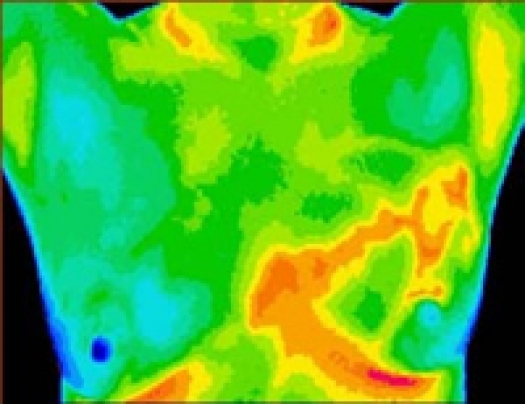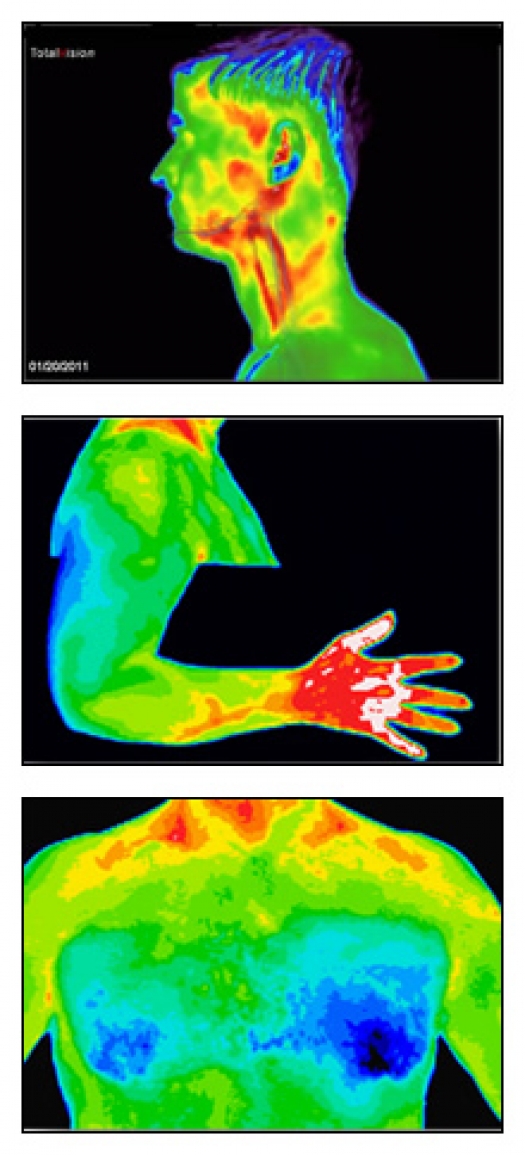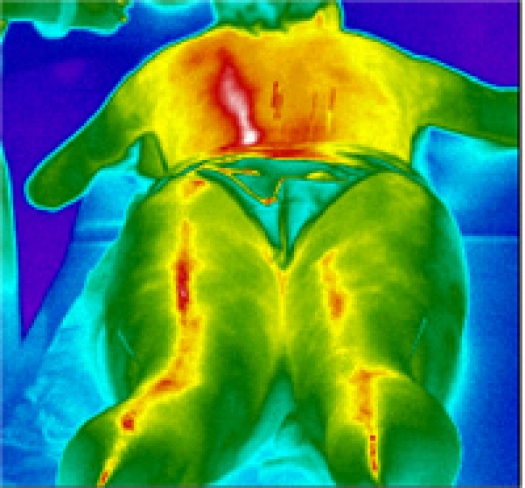thermalimagebreasts.jpg

Image courtesy of Carol Chandler, D.O.M. and Kimberly Schipke, M.S.
Image #1: Using medical thermal imaging, the neovascularization of breast cancer can be seen in the earliest stages when the tumor outgrows the host blood supply with no pain and with no exposure to ionizing radiation.
With over 8,000 journals published worldwide, medical thermal imaging has plenty of research to support its use for non-invasive and preventative screening. Most recently it has been promoted for use in early detection of breast cancer.
Using medical thermal imaging, the neovascularization of breast cancer can be seen in the earliest stages when the tumor outgrows the host blood supply with no pain and with no exposure to ionizing radiation. Clinical thermographers can also monitor areas under the arms where mammograms are unable to image which increases the potential for early detection in those areas. Cancer treatments can be monitored for new blood vessel formation and recession. The physiology and energy consumption of the tumor can be used to help examine growth.
No painful compression of the breasts is required for thermal imaging. Women with breast implants should consider using thermal imaging to monitor for infections due to implant leakage. The fatigue rate of the encasing material (approximately ten years) and the length of time the implants have been within the body affects its resistance to impact. The annual exposure to the high compressive force of the mammogram could cause cracks which lead to a further degradation.
Cardiovascular Disease
thermographycarotidarterypix.jpg

Images courtesy of Carol Chandler, D.O.M. and Kimberly Schipke, M.S.
Image #2: Thermal imaging reveals inflammation (shown as red) within the carotid artery.
Medical infrared imaging is a great tool for cardiologists who believe in utilizing tools for disease prevention. According to the U.S. National Heart, Lung, and Blood Institute almost half of the people who die of heart attacks have what is considered "normal" cholesterol levels. Upon autopsy they also found that the majority died from small cholesterol plaques.
In Image #2, you can see inflammation within the carotid artery although normal cholesterol levels are reported. Medical thermal imaging can be an early indicator that a change in diet or other medical treatments may be necessary. Help your community be proactive about their heart health and lifestyle.
Acupuncture
thermalimageknees.jpg

Images courtesy of Carol Chandler, D.O.M. and Kimberly Schipke, M.S.
Image #3: Inflammation in a knee reduced over time by acupuncture.
Acupuncture is a form of Traditional Chinese Medicine which introduces thin needles into the body to influence energetic channels known as the meridians. Medical thermal imaging allows practitioners to pinpoint areas of focus and gives insight into the dynamics of energy flow during treatment.
Image #3 shows inflammation is present in the person's knee, as indicated by the color red. Acupuncture needles were inserted and pictures were taken every five minutes. Note the reduction in inflammation over time which not only confirms to the practitioner the treatment is successful, but also visually shows the patient the benefit of using acupuncture.
Orthopedic
Medical infrared imaging is an excellent tool for orthopedic doctors who believe in utilizing non-invasive screening tools for disease prevention and treatment monitoring. The body can be examined for locations of inflammation within the joints, as well as, muscle fatigue. Nerve damage can also be seen, as cold spots over vertebrae and along affected muscle tissue.
thermalimagebody.jpg

Image courtesy of Carol Chandler, D.O.M. and Kimberly Schipke, M.S.
Image #4
The anatomy of the body can be monitored by x-ray, CT scan and MRI; however, the physiology of the injury can be monitored by medical thermal imaging – both are necessary to gain more in-depth understanding of the body. Continuous use of x-ray can be harmful which is why medical infrared imaging offers a great option for routine clinical examinations.
Although thermography has proven itself as a great research and screening tool, it cannot be used diagnostic. As x-ray images require a doctor's interpretation to diagnose a broken bone, the training of a medical professional to analyze thermal images is crucial. Professional interpretation services are available with licensed, insured clinical thermographers who write detailed reports for the doctors and their clients. Medical thermal imaging plays a key role in mapping the disease patterns in the body to help prevent the full onset of disease and overall help cut the healthcare costs of expensive surgeries and lifelong dependency on pharmaceuticals.
For more information, see the Research Papers on the Medical Thermal Imaging website.
Note: In the United States, the FDA states that telethermography has only been cleared as an adjunct tool, to be used with other imaging techniques for detection of breast cancer or other uses.


